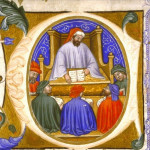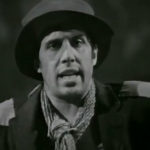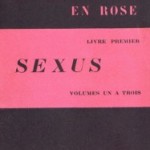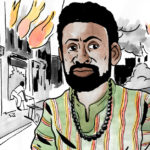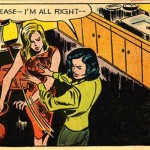
Guy Debord’s (1931–1994) best-known work,
La société du spectacle (
The Society of the Spectacle)
(1967), is a polemical and prescient indictment of our image-saturated
consumer culture. The book examines the “Spectacle,” Debord’s term for
the everyday manifestation of capitalist-driven phenomena; advertising,
television, film, and celebrity.
Debord defines the spectacle as the “autocratic reign of the market
economy.” Though the term “mass media” is often used to describe the
spectacle’s form, Debord derides its neutrality. “Rather than talk of
the spectacle, people often prefer to use the term ‘media,’” he writes,
“and by this they mean to describe a mere instrument, a kind of public
service.” Instead, Debord describes the spectacle as capitalism’s
instrument for distracting and pacifying the masses. The spectacle takes
on many more forms today than it did during Debord’s lifetime. It can
be found on every screen that you look at. It is the advertisements
plastered on the subway and the pop-up ads that appear in your browser.
It is the listicle telling you “10 things you need to know about ‘x.’”
The spectacle reduces reality to an endless supply of commodifiable
fragments, while encouraging us to focus on appearances. For Debord,
this constituted an unacceptable “degradation” of our lives.
Debord was a founding member of the
Situationist International
(1957–1972), a group of avant-garde artists and political theorists
united by their opposition to advanced capitalism. At varying points the
group’s members included the writers Raoul Vaneigem and Michèle
Bernstein, the artist Asger Jorn, and the art historian T.J. Clark.
Inspired primarily by Dadaism, Surrealism, and Marxist philosophy, the
SI rose to public prominence during the
May 1968 demonstrations during
which members of the group participated in student-led occupations and
protests. Though the extent of its influence is disputed, there is
little doubt that the SI played an active intellectual role during the
year’s events.
Graffiti daubed around Paris paraphrased the SI’s ideas and in some cases directly quoted from texts such as
The Society of the Spectacle and Raoul Vaneigem’s
The Revolution of Everyday Life (1967).

The first English translation of Debord’s text was published in 1970 by
Black and Red Books. The book’s cover features J.R. Eyerman’s
iconic photograph of the premiere of
Bwana Devil (1952), the first 3D color film. Originally reproduced in
LIFE
magazine, the image captures the film’s audience gazing passively at
the screen with the use of anaglyph glasses. In the foreground, a
besuited, heavy-set gentleman watches the screen intently, his mouth
agape. Eyerman’s photograph reduces the audience members to uniform rows
of spectacled spectators. Although the image encapsulates Debord’s
contempt for consumer culture, it reductively implies that his work was
mediaphobic (Debord later adapted
The Society of the Spectacle into his first
feature-length film by utilizing footage from advertisements, newsreels, and other movies). If we were to judge
The Society of the Spectacle
by Black and Red’s cover, we might assume that the book is a
straightforward critique of media-driven conformity. Debord’s insights
however, were far more profound.
The Society of the Spectacle consists of 221 short theses divided across nine chapters. The first thesis reworks the opening line of Karl Marx’s
Das Capital (1867):
Marx: The wealth of societies in which the capitalist
mode of production prevails presents itself as an immense accumulation
of commodities.
Debord: In societies where modern conditions of production prevail, all of life presents itself as an immense accumulation of spectacles. Everything that was directly lived has moved away into representation.
By paraphrasing Marx, Debord immediately establishes a connection
between the spectacle and the economy. The book essentially reworks the
Marxist concepts of
commodity fetishism and
alienation for the film, advertising, and television age. This concern is encapsulated by Debord’s fourth thesis (emphasis my own):
The Spectacle is not a collection of images, but a social relation among people, mediated by images.
Debord observed that the spectacle actively alters human interactions
and relationships. Images influence our lives and beliefs on a daily
basis; advertising manufactures new desires and aspirations. The media
interprets (and reduces) the world for us with the use of simple
narratives. Photography and film collapses time and geographic distance —
providing the illusion of universal connectivity. New products
transform the way we live. Debord’s notions can be applied to our
present-day reliance on technology. What do you do when you get lost in a
foreign city? Do you ask a passer-by for directions, or consult Google
Maps on your smartphone? Perhaps Siri can help. Such technology is
incredibly useful, but it also
engineers our behavior. It
reduces our lives into a daily series of commodity exchanges. If Debord
were alive today, he would almost certainly extend his analysis of the
spectacle to the Internet and social media. Debord would no doubt have
been horrified by social media companies such as Facebook and Twitter,
which monetize our friendships, opinions, and emotions. Our internal
thoughts and experiences are now commodifiable assets.
Did you tweet today? Why haven’t you posted to Instagram? Did you “like” your friend’s photos on Facebook yet?

To be clear, Debord did not believe that new technology was, in
itself, a bad thing. He specifically objected to the use of perceptual
technologies for economic gain. The spectacle, which is driven by
economic interest and profit, replaces lived reality with the
“contemplation of the spectacle.” Being is replaced by
having, and having is replaced by
appearing.
We no longer live. We aspire. We work to get richer. Paradoxically, we
find ourselves working in order to have a “vacation.” We can’t seem to
actually
live without working. Capitalism has thus completely
occupied social life. Our lives are now organized and dominated by the
needs of the ruling economy:
The alienation of the spectator to the profit of the
contemplated object is expressed in the following way: The more [the
spectator] contemplates the less he lives; the more he accepts
recognizing himself in the dominant images of need, the less he
understands his own existence and desires. – Thesis 30
The more his life is now his product, the more he is separated from his life. – Thesis 33
The proliferation of images and desires alienates us, not only from
ourselves, but from each other. Debord references the phrase “
lonely crowds,” a term coined by the American sociologist David Riesman, to describe our atomization.
The Society of the Spectacle’s
first chapter is entitled “Separation Perfected,” a quality that Debord
describes as the “alpha and omega of the spectacle.” Referring to the
Marxist concept of
false-consciousness,
Debord describes how the spectacle conceals the “relations among men
and classes.” The spectacle functions as a pacifier for the masses, a
tool that reinforces the status quo and quells dissent. “The Spectacle
presents itself as something enormously positive, indisputable and
inaccessible. It says nothing more than ‘that which appears is good,
that which is good appears,’” writes Debord. “It demands […] passive
acceptance which in fact it already obtained by its manner of appearing
without reply, by its monopoly of appearance.”

Although he characterizes the spectacle as a singular and omnipresent
“repressive pseudo-environment,” Debord also acknowledges its warring
and contradictory nature. “Every given commodity fights for itself,
cannot acknowledge the others, and attempts to impose itself everywhere
as if it were the only one,” reads thesis 66. As spectators, we
regularly experience advertisements for rival products — Pepsi and
Coca-Cola, Delta and US Airways,
The X-Factor and
The Voice.
Often we’re presented with conflicting desires or messages. For
instance, a television drama depicting an AA meeting might be preceded
by a glamorous vodka advertisement. Such logical inconsistencies are
buried by the spectacle’s relentless proffering of goods and imagery.
Gradually, we begin to conflate visibility with value. If something is
being talked about and seen, we assume that it must be important in some
way. “Thus by means of a ruse of
commodity logic,” writes
Debord, “what’s specific in the commodity wears itself out in the fight
while the commodity-form moves towards its absolute realization.” Put
more simply, our fetishization of images and commodities leads us to
overlook the spectacle’s contradictory qualities. “The spectacle, like
modern society, is at once unified and divided,” Debord observes. “Like
society, it builds its unity on the disjunction.” Debord’s
acknowledgement that the spectacle is comprised of competing agents and
interests strengthens his critical stance, since it prevents detractors
from accusing him of characterizing capitalism as a mindless, monolithic
entity.
Debord defines two primary forms of the spectacle — the
concentrated and the
diffuse.
The concentrated spectacle, which Debord attributes to totalitarian and
“Stalinist” regimes, is implemented through the cult of personality and
the use of force. The diffuse spectacle, which relies on a rich
abundance of commodities, is typified by wealthy democracies. The latter
is far more effective at placating the masses, since it
appears
to empower individuals through consumer choice. The diffuse spectacle
of modern capitalism propagates itself by exploiting the spectator’s
lingering dissatisfaction. Since the pleasure of acquiring a new
commodity is fleeting, it is only a matter of time before we pursue a
new desire — a new “fragment” of happiness. The consumer is thus
mentally enslaved by the spectacle’s inexorable logic: work harder, buy
more.

In his 1988 follow-up text,
Comments on the Society of the Spectacle, Debord introduces a third form: the
integrated.
As its name suggests, the integrated spectacle is a combination of
diffuse and concentrated elements. Debord bleakly concludes that the
integrated spectacle now permeates all reality. “There remains nothing,
in culture or nature, which has not been transformed, and polluted
according to the means and interests of modern industry,” he writes.
Today, the integrated spectacle continues to provide abundant
commodities while defending itself with the use of misinformation and
misdirection. According to Debord, it does this primarily through the
specter of terrorism:
Such a perfect democracy constructs its own inconceivable foe, terrorism. Its wish is to be judged by its enemies rather than by its results.
The story of terrorism is written by the state and it is therefore
highly instructive. The spectating populations must certainly never know
everything about terrorism, but they must always know enough to
convince them that, compared with terrorism, everything else seems
rather acceptable, in any case more rational and democratic.
Debord’s observation appears particularly prescient today when one
compares the amount of media coverage that terrorism receives in
comparison to climate change (the latter being the direct consequence of
our relentless consumerism). First time readers of Debord’s work may
prefer to read
Comments first, since it is a brisker and more informal read than
The Society of the Spectacle. Unlike his original text, Debord refers to contemporary events to illustrate his arguments, including the
Iran-Contra affair,
Manuel Noriega’s dictatorship of Panama, and the sinking of the
Rainbow Warrior.
Comments also examines the phenomenon of celebrity culture.
Debord observes that fame “has acquired infinitely more importance than
the value of anything one might actually be capable of doing.” Although
The Society of the Spectacle
largely focuses on broader themes such as alienation, Debord dedicates
two extended theses to the subject of “stars.” He is particularly
contemptuous of celebrities, branding them the “enemy of the
individual.” The star markets a lifestyle of leisure, “compensat[ing]
for the fragmented productive specializations that are actually lived.”

As embodiments of the spectacle, celebrities necessarily “renounce
all autonomous qualities in order to identify [themselves] with the
general law of obedience to the course of things.” Their Individuality
is sacrificed in order to become a figurehead of the profit-driven
system. After all, celebrities not only peddle commodities, but are
commodities themselves. They serve as projections of our false
aspirations. For Debord, this makes them less than human:
The admirable people in whom the system personifies
itself are well known for not being what they are; they became great men
by stooping below the reality of the smallest individual life, and
everyone knows it. – Thesis 61
Debord had an equally withering attitude towards the art world. In
Comments,
Debord blithely declares that “art is dead,” describing current
artistic practices as “recuperated neo-dadaism.” His conclusion is
unsurprising given the anti-art stance he extolled as a member of Paris’
avant-garde scene. His attitude towards art and art history is
exemplified by two key passages in
The Society of the Spectacle:
The affirmation of [art’s] independence is the beginning of its disintegration. – Thesis 186
When culture becomes nothing more than a commodity, it must also
become the star commodity of the spectacular society. – Thesis 193
Debord believed that Dadaism and Surrealism marked the end of modern
art, describing them as “the last great assault of the revolutionary
proletarian movement.” For Debord, art was another phenomenon that had
been subsumed by the spectacle. Its commodification reduced art
movements into “congealed past culture:”
Once this “collection of souvenirs” of art history becomes possible, it is also the end of the world of art.
In this age of museums, when artistic communication can no longer
exist, all the former moments of art can be admitted equally. – Thesis
189
Debord cites a study by Clark Kerr in which the economist suggested
that industries involving the “consumption of knowledge” (i.e. arts,
tech, and entertainment) would become the “driving force” in the
development of the US economy. It marks another instance in which
Debord’s observations appear to parallel our contemporary situation.
The Society of the Spectacle’s critical longevity can be
partly attributed to Debord’s refusal to describe the spectacle’s form.
By focusing instead on the spectacle’s ever-shifting qualities, Debord
encourages the reader to scrutinize the world around them. It is for
this reason that the book is routinely celebrated for its prescience. A
contemporary reader can readily apply Debord’s analysis to the
fracturing of the media industry, the rise of the internet, or to the
use of social media. Note how Debord starts multiple sentences with the
phrase “the spectacle is…”:
The spectacle is the other side of money: it is the general abstract equivalent of all commodities. – Thesis 49
The spectacle is nothing more than an image of happy unification
surrounded by desolation and fear at the tranquil center of misery. –
Thesis 63
The spectacle is absolutely dogmatic and at the same time cannot really achieve any solid dogma. – Thesis 71
Debord’s aggressive use of repetition parallels the spectacle’s
omnipresence and reinforces his critique. It’s a clever rhetorical
device. Full of pithy aphorisms,
The Society of the Spectacle
reads less like an academic text and more like a manifesto — a call to
arms against passive spectatorship. One of the book’s most cited
passages is the ninth thesis: “In a world which
really is topsy-turvy,
the true is a moment of the false.” As with the book’s opening
sentence, the ninth thesis plays off the work of another philosopher.
Debord’s aphorism is an inversion of a passage from the preface of Georg
Wilhelm Fredrich Hegel’s
The Phenomenology of Spirit (1807): “The false is a moment of the true.”
The Society of the Spectacle
is littered with both subtle and explicit references to the work of
other thinkers. Aside from Hegel and Marx, Debord also references György
Lukács, William Shakespeare, Arthur Schopenhauer, Ludwig Feuerbach, and
Niccolò Machiavelli. This meta-textual approach places Debord’s work
into a lineage of celebrated texts whilst also embodying the SI’s
concept of
détournement, a term variously translated as “diversion,” “detour,” “reroute,” and “hijack.”
The concept was initially devised by the
Letterist International (founded by Debord) and later revised by the SI. In a 1957 essay entitled “
A User’s Guide to Détournement” Debord and the artist Gil J. Wolman define the concept as:
The mutual interference of two worlds of feeling, or the
juxtaposition of two independent expressions, supersed[ing] the original
elements and produc[ing] a synthetic organization of greater efficacy.
The SI championed
détournement as a means of interrupting
the fabric of the everyday — whether it be repurposing old film reels,
subverting iconic images or slogans, or devising literature inspired by
the works of other writers. The concept bridges the appropriating
practices of avant-garde artists such as Marcel Duchamp, with the
activist “
culture jamming” of groups such as
The Yes Men and the
Billboard Liberation Front. In subverting and referencing the work of other authors, Debord uses
The Society of the Spectacle as a means of demonstrating its practical use. The act of
détournement imbues
revered and historicized works of art and literature with new life,
thereby overcoming their congealment at the hands of the spectacle. As
Debord and Wolman write:
Détournement not only leads to the discovery of
new aspects of talent; in addition, clashing head-on with all social and
legal conventions, it cannot fail to be a powerful cultural weapon in
the service of real class struggle.

The concept of
Détournement represented the synthesis of
many of Debord’s ideas, particularly his anti-art and anti-commodity
stances. He did however, acknowledge its weaknesses, namely that an act
of
détournement requires the viewer’s familiarity with the original, pre-
détourned subject matter. Debord compensates for this in
The Society of the Spectacle by
preceding each chapter with a prominent quote, thereby alerting the
reader to the meta-textual nature of his work. Despite its cultural
influence, the concept of
détournement raises a number of questions. For instance, how does one measure the efficacy of a
détourned work? Can a
détourned work be subsumed by the spectacle, and if so, how does one prevent such an action?
Although
The Society of the Spectacle is recognized as an
incisive indictment of the consumerist experience, readers may well
reject Debord’s assertion that capitalism has inherently degraded our
social lives. After all, how can society produce new services and
products without some form of industrialization? On this particular
point, Debord is unrelenting, arguing that capitalism — having already
served our most basic survival needs (the means to food, shelter, etc.) —
relies on fabricating new desires and distractions in order to
propagate itself and maintain its oppression over the working classes:
The new privation is not far removed from the old penury
since it requires most men to participate as wage workers in the endless
pursuit of […] attainment … everyone knows he must submit or die. The
reality of this blackmail accounts for the general acceptance of the
illusion at the heart of the consumption of modern commodities. – Thesis
47
At the heart of Debord’s critique is his belief that capitalism is an inherently
uncreative system. The obsession with profit demonstrably works
against human interest, especially when it comes to the protection of the environment. In
Comments,
Debord quotes Daniel Verilhe, a representative of Elf-Aquitaine’s
chemicals subsidiary, who, at a conference regarding a ban of
chlorofluorocarbons (CFCs) argued that it would take at “least three
years to develop substitutes and the costs will be quadrupled.” “As we
know, this fugitive ozone layer, so high up, belongs to no one and has
no market value,” scoffs Debord.
The most significant criticism that can be leveled at
The Society of the Spectacle
is Debord’s failure to proffer any convincing solutions for countering
the spectacle, other than describing an abstract need to put “practical
force into action.” In his final thesis, Debord declares the pressing
need for “self-emancipation” from the spectacle:
This “historical mission of installing truth in the
world” can not be accomplished either by the isolated individual, or by
the atomized crowd subjected to manipulation, but now as ever by the
class which is able to effect the dissolution of all classes by bringing
all power into the dealienating form of realized democracy, the
council, in which practical theory controls itself and sees its own
action. This is only possible where individuals are “directly linked to universal history”; only where dialogue arms itself to make its own conditions victorious.” – Thesis 221
In 1994, six years after he described the spectacle as “the most
important event to have occurred this century,” Debord killed himself at
his home in the remote French village of Champot. A life of hard
drinking had led to a diagnosis of peripheral neuritis, a debilitating
and extremely painful condition whereby the body’s nerve endings burn
away. By most accounts, Debord had long since retreated from the French
intellectual scene, spending his days drinking with friends and
obsessively engaged in games of strategy (Atlas Press republished
A Game of War,
which Debord co-authored with his wife Alice Becker-Ho, in 2008).
Andrew Hussey, a biographer of Debord, described his decline as “a slow
suicide.” In an 2001 article for the
Guardian, Hussey wrote:
It depressed him in his later years that [his] insight
had long since ceased to be a revolutionary call to arms but the most
accurate, if banal, description of modern life […] While Debord’s public
life was predicated upon his revolutionary intentions, in private he
sought oblivion in infamy, exile and alcoholism.

“Of the small number of things which I have liked and done well,
drinking is by far the thing I have done best,” Debord quips in his 1989
memoir. “Although I have read a lot, I have drunk more. I have written
much less than most people who write; but I have drunk more than the
majority of the people who drink.” Indeed, for someone who wrote
comparatively little, Debord cast a huge shadow over postmodern theory
and discourse. His interrogation of capitalism and visual culture
preempted the work of theorists such as
Jean Braudrillard and
Jean-Francois Lyotard, each of whom dedicated their work to the frenetic and orgiastic world of images in which we live.
Although the ‘spectacle’ has become a clichéd term for the modern
condition, there is no denying the richness of Debord’s original text.
The Society of the Spectacle
is littered with tangential lines of enquiry such as the psychological
impact of modernist architecture, or the nature of celebrity. Each
successive reading unveils another layer of nuance. For instance, take
this passage in which Debord reflects upon a quote by the sociologist
Joseph Gabel:
The need to imitate which is felt by the consumer is
precisely the infantile need conditioned by all the aspects of his
fundamental dispossession. In the terms applied by Gabel to a completely
different pathological level, “the abnormal need for representation
here compensates for a tortuous feeling of being on the margin of
existence.” – Thesis 219
Note the words “need” and “representation.” Ask yourself — what
compels us to buy the latest tech gadget? Why do we spill our feelings
out on Facebook, in posts that are archived on servers deep underground?
Which is more important, the expression of the feeling itself, or the
knowledge that it will be documented and
seen by others? Why do
we incessantly take selfies, or record our every moment for posterity?
Are we afraid of being a nobody — of being on “the margin of existence?”
If you’re concerned with how you
appear, then are you really
living? Even now, almost 50 years after its original publication,
The Society of the Spectacle reads as if it were written for our time:
The spectators consciousness, imprisoned in a flattened universe, bound by the screen of the spectacle behind which his life has been deported, knows only the fictional
speakers who unilaterally surround him with their commodities and the
politics of their commodities. The spectacle, in its entirety, is his
“mirror image.” – Thesis 218

-
Get Hyperallergic in your Inbox!
Subscribe to our email newsletter. (Daily or Weekly)







